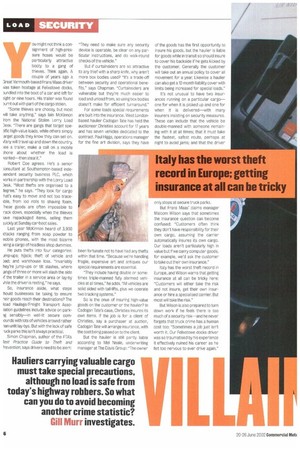Y ou might not think a consignment of high-pressure hoses would
Page 46

If you've noticed an error in this article please click here to report it so we can fix it.
be particularly attractive booty to a gang of thieves. Think again. A couple of years ago a 3reat Yarmouth-based Frans Maas driver was taken hostage at Felixstowe docks, )undled into the boot of a car and left for tight or nine hours. His trailer was found )urnt out with part of the cargo stolen.
Some thieves are choosy, but most gill take anything," says lain McKinnon 'nom the National Stolen Lorry Load )esk. 'There are gangs that target spe3ific high-value loads, while others simply arget goods they know they can sell on. any will travel up and down the country, we a trailer, make a call on a mobile tone about whether the load is vanted—then steal it."
Robert Coe agrees. He's a senior )onsultant at Southampton-based inde)endent security business PLC, which vorks in partnership with the Lorry Load )esk. "Most thefts are organised to a iegree," he says. "They look for cargo hat's easy to move and not too tracedale, from be rolls to shaving foam. -hese goods are often impossible to rack down, especially when the thieves lave repackaged items, selling them iuickly at Sunday car-boot sales.
Last year McKinnon heard of 3,900 ittacks ranging from soap powder to nobile phones, with the most bizarre ieing a cargo of headless shop dummies. He puts thefts into four categories: imp-ups; hijack; theft of vehicle and ad: and warehouse loss. "Invariably hey're jump-ups or tilt slashes, where angs of three or more will slash the side if the trailer in a service area or lay-by while the driver is resting," he says.
So, insurance aside, what steps hould businesses be taking to ensure heir goods reach their destinations? The load Haulage/Freight Transport Assoiation guidelines include advice on park* sensibly—in well-lit secure comounds with lots of vehicles around rather ian unlit lay-bys. But with the lack of safe -rick parks this isn't always practical.
Simon Chapman, author of the FTA's test Practice Guide to Theft and 'revention, says drivers need to be alert: "They need to make sure any security device is operable, be clear on any particular instructions, and do walk-round checks of the vehicle."
But if curtainsiders are so attractive to any thief with a sharp knife, why aren't more box bodies used? "It's a trade-off between security and operational benefits," says Chapman. "Curtainsiders are vulnerable but they're much easier to load and unload from, so using box bodies doesn't make for efficient turnaround."
For some loads special requirements are built into the insurance. West Londonbased haulier Cadogan Tate has held the auctioneer Christies account for 17 years and has seven vehicles dedicated to the contract. Paul Higgs, operations manager for the fine art division, says they have been fortunate not to have had any thefts within that time. 'Because we're handling fragile, expensive art and antiques our special requirements are essential.
"They include having double or sometimes triple-manned fully alarmed vehicles at all times," he adds. "All vehicles are solid sided with tail-lifts, plus we operate two tracking systems."
So is the onus of insuring high-value goods on the customer or the haulier? In Cadogan Tate's case, Christies insures its own items. If the job is for a client of Christies, say a purchaser at auction, Cadogan Tate will arrange insurance, with the cost being passed on to the client.
But the haulier is still partly liable according to Mel Neale, underwriting manager at The Davis Group: "The owner of the goods has the first opportunity to insure his goods, but the haulier is liable for goods while in transit so should insure to cover his backside if he gets kicked by the customer. Generally the customer will take out an annual policy to cover all movement for a year. Likewise a haulier can also get a 12-month liability cover with limits being increased for special loads."
It's not unusual to have two insurances running on a particular cargo— one for when it is picked up and one for when it is delivered—with many insurers insisting on security measures. These can include that the vehicle be double-manned with someone remaining with it at all times; that it must take the fastest, safest route, perhaps at night to avoid jams; and that the driver only stops at secure truck parks.
But Frans Maas' claims manager Malcom Wilson says that sometimes the insurance question can become confused: "Customers often think they don't have responsibility for their own cargo, assuming the carrier automatically insures its own cargo. Our loads aren't particularly high in value but if we carry computer goods, for example, we'd ask the customer to take out their own insurance."
Italy has the worst theft record in Europe, and Wilson warns that getting insurance at all can be tricky here: "Customers will either take the risk and not insure, get their own insurance or hire a specialised carrier. But most will take the risk."
But Wilson is also prepared to turn down work if he feels there is too much of a security risk—and he never forgets that truck crime has a human cost too: "Sometimes a job just isn't worth it. Our Felixstowe docks driver was so traumatised by his experience it effectively ruined his career as he felt too nervous to ever drive again."
























































































































































